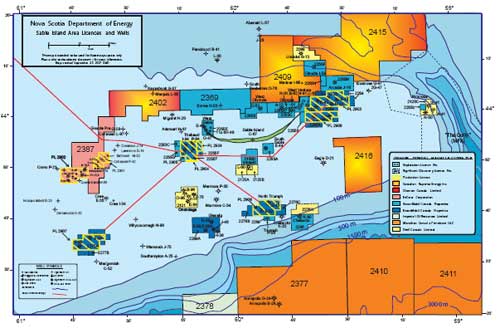NOVA SCOTIA CANADA: THE NEXT PLAY
New strategic licensing terms to spur exploration
Flexibility and lower costs key
After broad consultation and consideration of best practices worldwide, Nova Scotia is introducing new flexible terms and conditions for new Exploration Licences (ELs) to lower the cost of entry to offshore Nova Scotia.
“The changes now underway in offshore Nova Scotia will encourage others to take a closer look at our resource potential,” says Diana Dalton, Chair of the CNSOPB. “We at the Board are confident in our geological assessments, which point to excellent hydrocarbon potential in several areas.”
The key to this proactive approach is the flexibility and lower cost of the new EL system. It will have an initial term of up to three years, with minimal cost, which is not necessarily based on drilling commitments.
If the holder of the EL decides they are interested in further work after the third year (for instance, they want to drill a well) the license can be extended up to the maximum nine years, as set out in the legislation.
If they decide not to move forward, the license will revert to the Crown, and the CNSOPB will be able to publicly release certain geoscience data collected.
The board hopes this revised EL system will appeal to a broader range of companies, allowing them to do preliminary work without without costly upfront commitments. Currently, companies are required to pay upfront deposits into the millions of dollars. In future, it is conceivable they could get into the preliminary exploration phase for as little a $50,000 application fee and an approved work program.
The board is also considering more flexible terms and conditions for existing ELs.
It recently announced a proposed policy that gives companies the flexibility to extend Period 1 of an existing EL from 6 years up to the legislated 9-year maximum. Normally, after six years, if a company has not drilled a well the license expires. The proposed policy recognizes there are limited numbers of rigs that can work year-round in harsh and deep water environments like Nova Scotia.
In addition, the Board is examining how new technology is expanding exploration opportunities. Technology such as slimhole drilling, which substantially reduces costs for explorers, is being considered.

These changes resulted from a commissioned study to review Nova Scotia’s Rights Issuance System and to compare it with others worldwide. Those jurisdictions included Alberta, other frontier areas of Canada, as well as offshore petroleum jurisdictions around the world: the USA-Gulf of Mexico; the United Kingdom; Norway; Australia; New Zealand and Greenland.
The board also intends to issue a Call for Bids for new acreage in December 2007. In the past, the board relied exclusively on industry for the nomination of land parcels before issuing Calls for Bids. Beginning this year, the board will also select lands to be included in a regular Call for Bids. The last Call in offshore Nova Scotia was in 2003.
Just 204 wells have been drilled in the waters off Nova Scotia in the last 40 years. Over that same time period, about 10,000 were drilled in the North Sea, and 50,000 in the Gulf of Mexico. 
|



